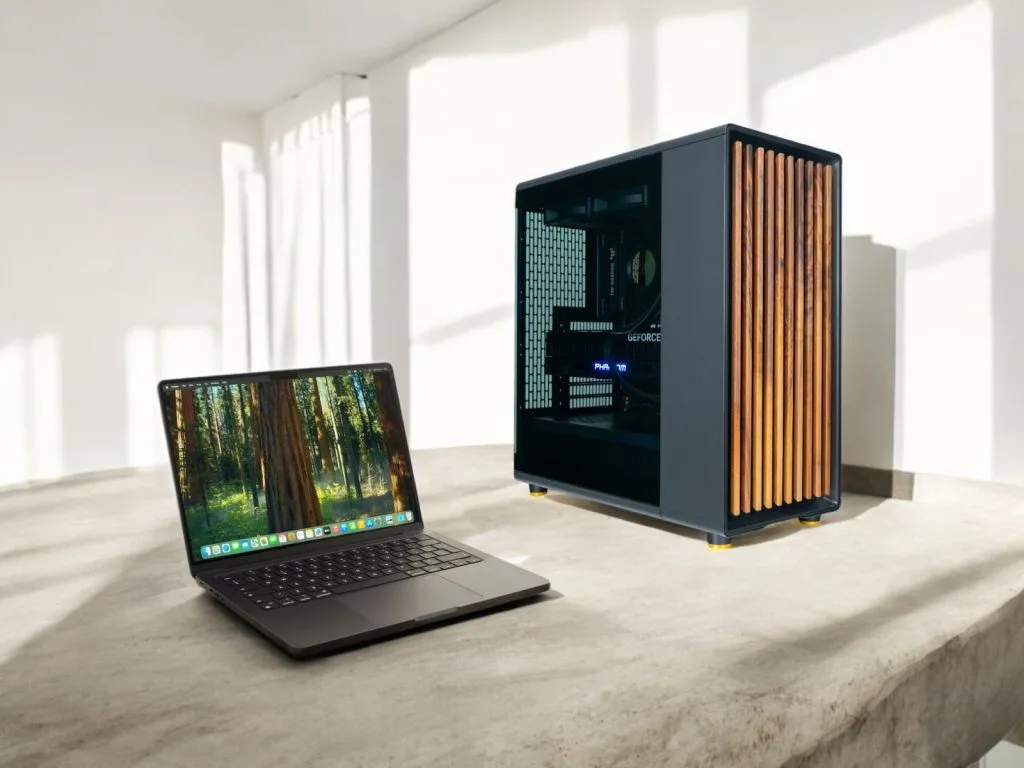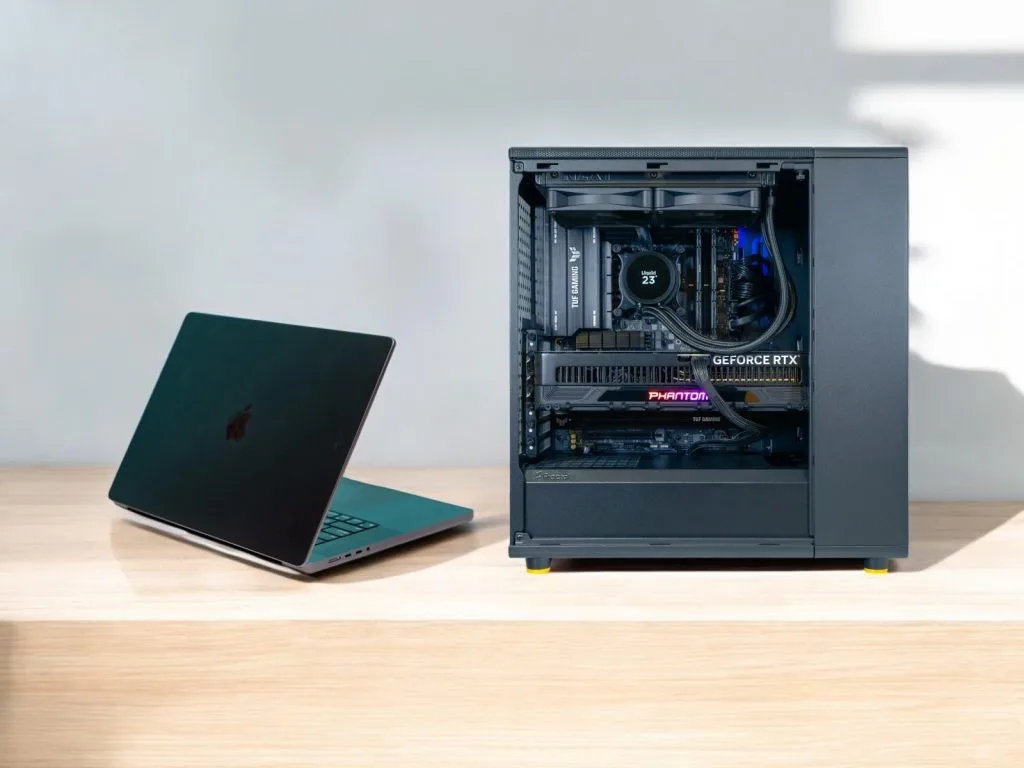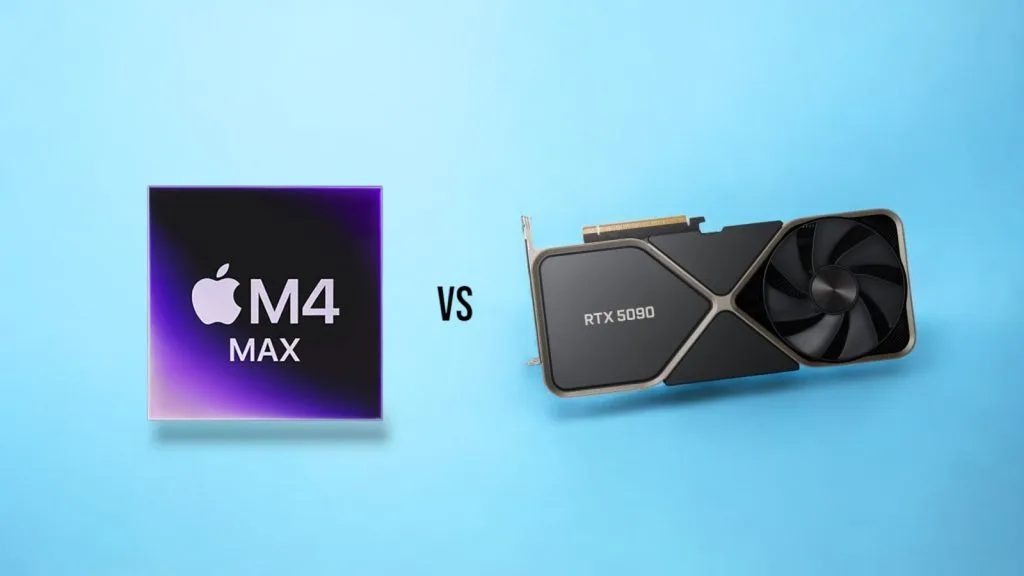I’ve always been fascinated by the endless battle between dedicated GPUs and integrated solutions for creative professionals.
Today, we’re examining two powerhouse options that represent the pinnacle of their respective approaches: Nvidia’s mighty RTX 5090 discrete GPU and Apple’s integrated M4 Max chip.
How do these technological marvels compare when handling demanding creative workloads?
This comprehensive comparison focuses exclusively on creator performance—leaving gaming benchmarks aside—to help you determine which solution might best suit your professional workflow.
Specifications Showdown: RTX 5090 vs M4 Max
Before diving into real-world performance, let’s examine how these two powerhouses stack up on paper:
The specifications reveal two fundamentally different approaches.
The RTX 5090 is a dedicated GPU powerhouse with exceptional raw performance and memory bandwidth.
The M4 Max is an integrated SoC offering impressive efficiency and a unified memory architecture that provides substantial memory capacity.
The test system for the RTX 5090 included an Intel Core i9-12900K with 64GB DDR4-3600 RAM on an Asus ROG Strix Z690-A motherboard.
While this creates a slight CPU bottleneck compared to newer processors, the GPU benchmarks remain highly relevant.
Benchmark Performance: The Ultimate Test
Numbers only tell part of the story.
Let’s explore how these two powerhouse systems perform in real-world creative applications that professional content creators depend on daily.
Geekbench 6: Raw GPU Compute
In Geekbench 6’s GPU compute test, the RTX 5090 demonstrates its raw processing advantage with a commanding lead.
Tech Notice’s comprehensive benchmarking reveals the OpenCL score of the 5090 outperforming the M4 Max by over 3 times with 354,423 points versus 116,141.
This substantial difference highlights the raw computing power advantage of Nvidia’s dedicated GPU architecture.
Even in Vulkan/Metal tests—where each platform runs its optimized API—the RTX 5090 maintains a significant advantage with 350,275 points versus the M4 Max’s 193,539 points.
This represents an 80.98% performance increase for the Nvidia card.
Photoshop: M4 Max Takes the Crown
Interestingly, Photoshop tells a different story.
The M4 Max system outperforms the RTX 5090 test system by a significant margin in the PugetBench benchmark.
Benchmark testing revealed the M4 Max scored 13,429 overall compared to the RTX 5090 system’s 8,968—a 33.22% advantage for Apple’s chip.
This demonstrates how the integrated nature of the M4 Max, with its tightly coupled CPU and GPU on the same die, benefits applications that rely heavily on both processor types.
This result underscores an important point: having the most powerful GPU doesn’t automatically translate to better performance in all creative applications. Photoshop’s performance depends significantly on single-core CPU speed and efficient memory access—areas where Apple’s integrated architecture shines.
Premiere Pro: Workflow-Dependent Performance
Adobe Premiere Pro shows more nuanced results that depend on the specific workflow.
In PugetBench for Premiere Pro, the RTX 5090 system scored 13,048 in Standard Overall performance—approximately 5.22% faster than the M4 Max’s 12,401.
However, in Extended Overall tests, the M4 Max pulled ahead with 9,697 points versus 8,878 for the RTX 5090 system—an 8.45% advantage.
The breakdown of specific tasks reveals interesting patterns:
- For Long GOP codecs (like H.264/H.265): The RTX 5090 was faster in standard tests but slower in extended tests
- For Intraframe codecs (like ProRes): The M4 Max was significantly faster (50.10% advantage), likely due to Apple’s dedicated ProRes acceleration
- For RAW footage: The RTX 5090 system performed 84.71% better in standard tests
- For GPU Effects: The RTX 5090 demonstrated clear advantages (46.67% faster in standard tests, 84.90% faster in extended tests)
The tests revealed that Premiere Pro didn’t fully utilize all the hardware acceleration capabilities of the RTX 5090, particularly its advanced media engines that support 4:2:2 10-bit playback in hardware.
After Effects: Integrated Advantage
After Effects testing shows another win for Apple’s integrated approach.
In PugetBench for After Effects, the M4 Max system scored 1,892 points overall compared to the RTX 5090 system’s 1,265—a 33.14% advantage for Apple.
The M4 Max outperformed the RTX 5090 system across all test categories, with particularly strong results in multicore performance (28.11% faster) and RAM Preview (37.20% faster).
These results reflect After Effects’ dependency on strong CPU performance and efficient memory access rather than pure GPU power.
The M4 Max’s unified memory architecture proves advantageous for the complex compositing and motion graphics workflows typical in After Effects.
DaVinci Resolve: GPU Acceleration Shines
DaVinci Resolve, known for its excellent GPU utilization, shows more consistent advantages for the RTX 5090 across most workloads.
In overall tests, the RTX 5090 system outperformed the M4 Max, particularly in Extended Overall scores where it was 34.72% faster.
The GPU Effects tests showed the most dramatic difference, with the RTX 5090 performing 149% better than the M4 Max.
Independent testing confirmed that while the MacBook Pro with M4 Max provided a smooth editing experience, the RTX 5090 delivered noticeably better performance when working with GPU-based effects and complex timelines.
Matthew Moniz noted in his comparison that when editing video compositions with GPU effects overlaid on the timeline, his M4 Max would occasionally slow down during scrubbing, while the RTX 5090 system maintained perfect smoothness.
Interestingly, the M4 Max still maintained advantages in ProRes and RAW workflows, highlighting Apple’s optimization for these professional codecs.
Blender: CUDA-Powered 3D Rendering Dominance
For 3D rendering in Blender, the RTX 5090 demonstrates its undisputed dominance with nearly three times the performance of the M4 Max.
The Monster benchmark showed the RTX 5090 scoring 7,311.1 points compared to the M4 Max’s 2,527.6—a 189.25% advantage.
Similar patterns appeared across other Blender benchmarks: JunkShop (158.90% faster) and Classroom (169.50% faster).
Comprehensive testing found the RTX 5090 delivered a 99% improvement over the MacBook Pro with M4 Max in Blender rendering tasks.
This exceptional performance gap demonstrates why dedicated GPUs—particularly those with CUDA cores—remain essential for professional 3D artists and animators.
AI Performance: Speed vs. Capacity
When it comes to AI tasks, the comparison reveals a fascinating trade-off between raw processing speed and memory capacity.
The RTX 5090, powered by its 5th Generation Tensor Cores, boasts vastly superior processing speed.
In rated AI performance (TOPS), the RTX 5090 delivers an incredible 3,352 TOPS (FP4), dwarfing the M4 Max’s 38 TOPS from its Neural Engine.
This translates to over 88 times the raw AI compute potential for certain tasks.
Geekbench 6 AI benchmarks further confirm this speed advantage, showing the RTX 5090 significantly outperforming the M4 Max across single-precision (+100%), half-precision (+154%), and quantized operations (+46%).
However, raw speed isn’t the only factor, particularly when running large language models (LLMs) locally.
The RTX 5090 is equipped with 32GB of fast GDDR7 VRAM, which limits the size of the largest AI models it can run directly in memory.
Conversely, the M4 Max, with its access to up to 128GB of unified memory, can load and run substantially larger local LLMs that simply wouldn’t fit on the RTX 5090.
Therefore, the choice depends heavily on your specific AI workflow.
If you need maximum speed for AI-assisted tools, generative tasks with smaller models, fine-tuning, or development requiring CUDA, the RTX 5090’s processing power is unmatched.
However, if your priority is running the largest possible language models locally on a single machine, the M4 Max’s superior memory capacity makes it the more capable option, despite its significantly slower inference speeds.
Power Consumption and Thermal Efficiency
Perhaps the most striking contrast between these systems is their power consumption.
The RTX 5090 draws up to 575 watts at peak performance, requiring a minimum 1000W power supply for the system.
In contrast, the M4 Max has a rated TDP of just 75 watts, though benchmark testing typically showed around 50-60 watts during operation.
This means the M4 Max delivers its performance while consuming approximately 1/7th the power of the RTX 5090.
This impressive efficiency achievement makes it particularly suitable for portable workstations and environments where power consumption or heat generation are concerns.
Pros and Cons: RTX 5090 vs M4 Max


Based on the benchmark data and specifications, let’s analyze the strengths and limitations of each platform.
RTX 5090 Advantages:
- Unmatched raw GPU performance, especially in professional 3D rendering
- Superior AI processing capabilities (88x faster in some metrics)
- Exceptional memory bandwidth (1,792 GB/s)
- Excellent performance in GPU-accelerated applications like DaVinci Resolve
- Advanced media engines with dual decoders for efficient video processing
- Lower initial cost compared to a complete M4 Max system ($1,999 vs $5,000+)
- CUDA ecosystem support critical for many professional applications
RTX 5090 Limitations:
- Extremely high power consumption (575W)
- Requires a powerful cooling solution
- Limited to 32GB VRAM (though extremely fast)
- Requires additional system components (CPU, motherboard, etc.)
- Not available in portable form factors
- Some applications don’t fully utilize its capabilities
M4 Max Advantages:
- Exceptional power efficiency (75W TDP)
- Massive 128GB unified memory capacity (enables running large local AI models)
- Superior performance in CPU-dependent applications like Photoshop
- Excellent ProRes and RAW video codec handling
- Available in portable laptop form factors
- All-in-one solution with integrated CPU, GPU, and Neural Engine
- 3nm process node advantage
- Runs cool even under sustained loads
M4 Max Limitations:
- Significantly lower raw GPU performance for 3D rendering
- Significantly lower AI processing speed, but superior capacity for running large local LLMs thanks to 128GB memory
- Lower memory bandwidth (546 GB/s)
- Higher system cost when purchased within a MacBook Pro
- Lacks CUDA support for certain professional applications
- Limited to macOS ecosystem
Who Should Buy the RTX 5090?
The RTX 5090 is the clear choice for:
- 3D artists and animators: The nearly 3x performance advantage in Blender makes it essential for professional 3D artists and animators
- AI researchers and developers: With 88x faster AI performance in some metrics, it’s unmatched for AI development
- VFX professionals: The superior GPU effects performance in DaVinci Resolve benefits complex visual effects work
- Large language model users: The high memory bandwidth and CUDA acceleration make it ideal for running AI models locally
- Multi-GPU workstation builders: The relatively slim design allows for multiple cards in a single workstation
Who Should Not Buy the RTX 5090:
You should avoid the RTX 5090 if you’re:
- A mobile creator: The high power requirements make it unsuitable for laptop implementations
- Primarily Photoshop-focused: The M4 Max actually outperforms it in many Photoshop workflows
- Working with limited power capacity: The 575W draw plus system requirements demand robust power infrastructure
- On a tight budget: While cheaper than a complete M4 Max system, it still requires substantial additional components
Who Should Buy the M4 Max?
The M4 Max is ideal for:
- Mobile creative professionals: Its efficiency makes it perfect for mobile creative professionals
- Photoshop power users: It outperforms much more power-hungry systems in Photoshop workflows
- Video editors working with ProRes: The dedicated ProRes acceleration provides excellent performance
- Creators needing massive memory: The 128GB unified memory offers advantages for memory-intensive workflows
- Those prioritizing efficiency: The performance-per-watt ratio is unmatched in the industry
- Mac ecosystem devotees: It provides the best possible performance within Apple’s ecosystem
Who Should Not Buy the M4 Max:
You’ll likely be disappointed with the M4 Max if you’re:
- A professional 3D artist: If you rely on Blender or similar applications, you’ll face significant performance limitations
- Focused on AI development: The limited AI processing power makes it unsuitable for serious AI development work
- Dependent on CUDA workflows: If your applications require CUDA acceleration, you’ll find it completely unavailable on M4 Max
- Shopping on a tight budget: When considering performance per dollar in certain applications, the high system cost may be difficult to justify
Frequently Asked Questions
Is RTX 5090 better than M4 Max?
The RTX 5090 delivers significantly better performance in GPU-intensive tasks like 3D rendering (nearly 3x faster in Blender) and AI workloads (up to 88x faster in some metrics).
However, the M4 Max outperforms the RTX 5090 in Photoshop by 33% and offers superior power efficiency, drawing only about 1/7th the power while providing competitive performance in many creative applications.
How fast is the RTX 5090 for AI?
The RTX 5090 delivers exceptional AI performance with 3,352 TOPS (trillions of operations per second) in FP4 precision—approximately 88 times faster than the M4 Max’s 38 TOPS.
In Geekbench 6 AI benchmarks, it outperforms the M4 Max by 100% in single-precision workloads and 154% in half-precision tasks, making it the superior choice for AI development and generative AI workflows.
It’s worth noting, though, that the M4 Max’s higher unified memory capacity (up to 128GB) allows it to run larger local language models than the RTX 5090’s 32GB VRAM can accommodate.
Is M4 Max good for 3D rendering?
While the M4 Max can handle 3D rendering tasks, it falls significantly behind dedicated GPUs like the RTX 5090.
In Blender benchmarks, the RTX 5090 outperformed the M4 Max by nearly 3x (189% faster) in the Monster benchmark.
For professional 3D artists and animators who primarily focus on rendering, the RTX 5090 offers substantially better performance despite its higher power requirements.
What is the power draw of RTX 5090?
The RTX 5090 has a Total Graphics Power (TGP) rating of 575 watts, requiring a system power supply of at least 1000 watts.
This represents approximately 7 times the power consumption of the M4 Max, which has a TDP of 75 watts.
The high power requirements necessitate robust cooling solutions and limit the RTX 5090 to desktop workstations rather than portable systems.


Should I buy RTX 5090 or M4 Max?
Your choice should depend on your specific workflow.
Choose the RTX 5090 if you primarily work with 3D rendering, AI development, or GPU-accelerated applications and don’t require mobility.
Choose the M4 Max if you need portability, work primarily with Photoshop or ProRes video, value power efficiency, or are committed to the macOS ecosystem.
Consider your most demanding applications and which system performs better in those specific tasks.
How does M4 Max unified memory work?
The M4 Max features a unified memory architecture where both the CPU and GPU access the same physical memory pool (up to 128GB).
This eliminates the need to copy data between separate CPU and GPU memory spaces, reducing latency and potentially improving performance for workflows that frequently transfer data between processor types.
The unified approach also allows the GPU to access much more memory than traditional discrete GPUs, though at lower bandwidth than GDDR7.
RTX 5090 system requirements?
The RTX 5090 requires a minimum 1000W power supply (Nvidia recommends a PCIe CEM 5.1 compliant PSU), a PCIe 5.0 compatible motherboard, and sufficient case cooling to handle its thermal output.
It requires either 4x PCIe 8-pin power cables (adapter included) or a single 600W PCIe Gen 5 power cable.
The card occupies 2 slots and measures 304mm in length by 137mm in width, requiring adequate case space.
M4 Max laptop options?
The M4 Max is currently available in the 14-inch and 16-inch MacBook Pro models.
The 16-inch configuration offers the highest performance potential with better thermal management.
When configured with the 40-core GPU and 128GB unified memory, pricing starts around $5,000.
Beyond laptops, the M4 Max chip is also featured in the Mac Studio desktop, which may offer slightly better sustained performance due to its enhanced thermal design; my recent review provides detailed benchmarks for creative apps and AI model performance in this desktop form factor.
Conclusion: Choosing Based on Your Creative Workflow
The comparison between the RTX 5090 and Apple M4 Max reveals two exceptional but fundamentally different approaches to high-performance computing for creative professionals.
The RTX 5090 represents the pinnacle of dedicated GPU performance, delivering exceptional results in 3D rendering, AI processing speed, and GPU-accelerated effects.
Its raw computational power makes it indispensable for professionals in these fields despite its significant power requirements.
The M4 Max showcases Apple’s integrated approach, combining impressive performance with remarkable efficiency.
Its unified memory architecture and tightly coupled CPU/GPU design excel in applications like Photoshop and ProRes video editing, while its power efficiency enables high performance in portable form factors.
Your ideal choice depends entirely on your specific creative workflow:
- You should choose the RTX 5090 if maximum GPU performance, 3D rendering capabilities, or AI processing speed and CUDA compatibility are your priorities
- You’ll be better served by the M4 Max if efficiency, portability, Photoshop performance, the ability to run very large local AI models, or integration with the Apple ecosystem are more important
For many studios, the ideal solution might be having both available: M4 Max systems for mobile work and initial content creation, with RTX 5090 workstations available for final rendering and AI-intensive tasks.
As the creative technology landscape continues to evolve, we’re fortunate to have such powerful and distinctive options available.
Whether you choose the brute force approach of the RTX 5090 or the efficient integration of the M4 Max, today’s high-end hardware enables creative possibilities that would have seemed impossible just a few years ago.



